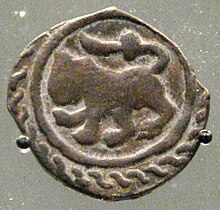Al-Ashraf Nasir-ad-Din Shaban II
| Sha'ban | |||||
|---|---|---|---|---|---|
| Al-Malik al-Ashraf | |||||

|
|||||
| Sultan of Egypt | |||||
| Reign | 29 May 1363–15 March 1377 | ||||
| Predecessor | Al-Mansur Muhammad | ||||
| Successor | Ali | ||||
| Born | 1353/54 | ||||
| Died | 15 March 1377 | ||||
| Burial | Cairo | ||||
| Issue | Al-Mansur Ali Abu Bakr Ahmad Ramadan Qasim Muhammad Isma'il As-Salih Hajji |
||||
|
|||||
| House | Qalawuni | ||||
| Dynasty | Bahri | ||||
| Father | Al-Amjad Husayn | ||||
| Religion | Islam | ||||
| Full name | |
|---|---|
| Al-Malik al-Ashraf Zayn ad-Din Abu al-Ma'ali Sha'ban ibn Husayn ibn Muhammad ibn Qalawun |
Al-Ashraf Zayn ad-Din Abu al-Ma'ali Sha'ban ibn Husayn ibn Muhammad ibn Qalawun, better known as al-Ashraf Sha'ban or Sha'ban II, was a Mamluk sultan of the Bahri dynasty in 1363–1377. He was a grandson of Sultan an-Nasir Muhammad (r. 1310–1341). He had two sons (out of a total of eight) who succeeded him: al-Mansur Ali and as-Salih Hajji.
Sha'ban was born in 1353/54. His father was al-Amjad Husayn (died 1363), a son of Sultan an-Nasir Muhammad (r. 1310–1341) who, unlike many of his brothers, never reigned as sultan. Sha'ban's mother was Khawand Baraka (d. 1372), a former slave woman who married al-Amjad Husayn. Sha'ban had four brothers, Anuk (d. 1390/91), Ibrahim, Ahmad and Janibak (d. 1428), and three sisters, Zahra (d. 1370), Shaqra (d. 1401) and Sara (d. 1432).
In late May 1363, the Mamluk magnates, in effect the senior emirs, led by Emir Yalbugha al-Umari, deposed Sultan al-Mansur Muhammad on charges of illicit behavior and installed al-Ashraf Sha'ban, then ten years old, as his replacement. Yalbugha and the emirs viewed al-Ashraf Sha'ban as a figurehead who would be easy to manage. Yalbugha maneuvered to become the effective regent of the sultan. In December 1366, a number of senior emirs and Yalbugha's own mamluks launched a revolt against him. At the start of the revolt, a significant number of Yalbugha's mamluks remained loyal to their master, but once al-Ashraf Sha'ban, who sought to rule in his own right, lent his support to the rebels, they too joined the revolt.
After Yalbugha was captured and killed by his mamluks, al-Ashraf Sha'ban made a number of them emirs, but most were left without employment or a patron. At that point, al-Ashraf Sha'ban had only 200 of his own mamluks, the relatively low number being attributed to his lack of real power during Yalbugha's regency. By June 1367, Yalbugha's former mamluks had largely entered the services of Emir Asandamur an-Nasiri, who had neutralized his rival emirs.
In late 1367, Asandamur and his newly-acquired mamluks moved against al-Ashraf Sha'ban, but were defeated. The revolt was also supported by Emir Khalil ibn Qawsun, the son of former regent Emir Qawsun (d. 1342) and a daughter of an-Nasir Muhammad who had been appointed atabeg al-asakir (commander in chief) by al-Ashraf Sha'ban earlier that year. Khalil had been promised the throne by Asandamur. According to a contemporary Mamluk chronicler, al-Nuwayri al-Iskandarani, al-Ashraf Sha'ban was significantly assisted by the "common people", who killed many of the mamluk rebels, "making them bite the dust". The support of the commoners was enlisted by al-Ashraf Sha'ban's loyalist commanders, emirs Asanbugha Ibn al-Abu Bakri and Qushtamur al-Mansuri, both of whom withdrew from the battle in Cairo and left the commoners to fight Asandamur's forces alone. The commoners were able to turn the tide in favor of al-Ashraf Sha'ban's partisans, and the latter's emirs and Royal Mamluks returned to the battle, defeated the rebels and arrested Asandamur. Because of their loyalty and key support during the revolt, al-Ashraf Sha'ban treated the commoners well throughout his reign.
...
Wikipedia
